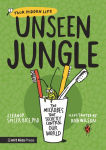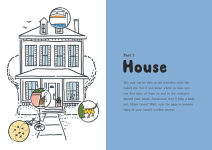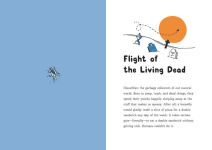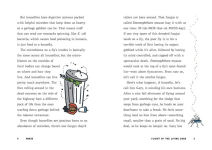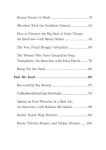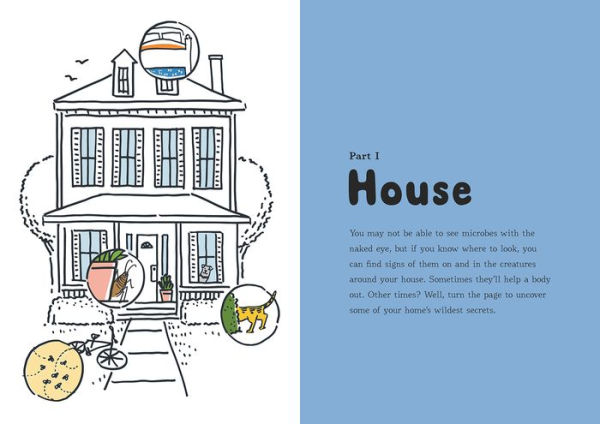This lively peek into the amazing world of microbes, replete with a kid-pleasing “ick” factor, is chock-full of facts, humor, and fun illustrations.
Microbes are everywhere: outside, indoors, on your body, in your body. In fact, only about half of our bodies’ cells are human cells—the rest are microbes. Whether helping people digest their food or using mind-control techniques to lure mice into the path of hungry cats (no, really), microbes form an unseen jungle all around us. Through zany facts, hilarious and sometimes disgusting illustrations, and interviews with experts in their fields, aspiring young scientists (or kids who just want to be grossed out) will discover a hidden world in which your health depends on a myriad of microbes, houseflies get zombified by fungi, and termites are saving the planet one fart at a time. With fun extras, including sidebars, limericks, and even a lesson on how to draw E. coli, this “eww”-worthy treasure trove for kids is an engrossing romp into the microbe drama unfolding where you might least expect it.
1141941884
Microbes are everywhere: outside, indoors, on your body, in your body. In fact, only about half of our bodies’ cells are human cells—the rest are microbes. Whether helping people digest their food or using mind-control techniques to lure mice into the path of hungry cats (no, really), microbes form an unseen jungle all around us. Through zany facts, hilarious and sometimes disgusting illustrations, and interviews with experts in their fields, aspiring young scientists (or kids who just want to be grossed out) will discover a hidden world in which your health depends on a myriad of microbes, houseflies get zombified by fungi, and termites are saving the planet one fart at a time. With fun extras, including sidebars, limericks, and even a lesson on how to draw E. coli, this “eww”-worthy treasure trove for kids is an engrossing romp into the microbe drama unfolding where you might least expect it.
Unseen Jungle: The Microbes That Secretly Control Our World
This lively peek into the amazing world of microbes, replete with a kid-pleasing “ick” factor, is chock-full of facts, humor, and fun illustrations.
Microbes are everywhere: outside, indoors, on your body, in your body. In fact, only about half of our bodies’ cells are human cells—the rest are microbes. Whether helping people digest their food or using mind-control techniques to lure mice into the path of hungry cats (no, really), microbes form an unseen jungle all around us. Through zany facts, hilarious and sometimes disgusting illustrations, and interviews with experts in their fields, aspiring young scientists (or kids who just want to be grossed out) will discover a hidden world in which your health depends on a myriad of microbes, houseflies get zombified by fungi, and termites are saving the planet one fart at a time. With fun extras, including sidebars, limericks, and even a lesson on how to draw E. coli, this “eww”-worthy treasure trove for kids is an engrossing romp into the microbe drama unfolding where you might least expect it.
Microbes are everywhere: outside, indoors, on your body, in your body. In fact, only about half of our bodies’ cells are human cells—the rest are microbes. Whether helping people digest their food or using mind-control techniques to lure mice into the path of hungry cats (no, really), microbes form an unseen jungle all around us. Through zany facts, hilarious and sometimes disgusting illustrations, and interviews with experts in their fields, aspiring young scientists (or kids who just want to be grossed out) will discover a hidden world in which your health depends on a myriad of microbes, houseflies get zombified by fungi, and termites are saving the planet one fart at a time. With fun extras, including sidebars, limericks, and even a lesson on how to draw E. coli, this “eww”-worthy treasure trove for kids is an engrossing romp into the microbe drama unfolding where you might least expect it.
12.99
In Stock
5
1

Unseen Jungle: The Microbes That Secretly Control Our World
176
Unseen Jungle: The Microbes That Secretly Control Our World
176
12.99
In Stock

Product Details
| ISBN-13: | 9781536232868 |
|---|---|
| Publisher: | Candlewick Press |
| Publication date: | 10/31/2023 |
| Series: | Your Hidden Life |
| Pages: | 176 |
| Product dimensions: | 6.06(w) x 8.50(h) x 0.55(d) |
| Age Range: | 7 - 10 Years |
About the Author
From the B&N Reads Blog
